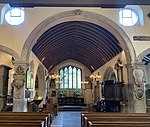Cheyne Walk
Buildings and structures on the River ThamesChelsea, LondonStreets in the Royal Borough of Kensington and ChelseaUse British English from June 2015Vague or ambiguous time from September 2022

Cheyne Walk is a historic road in Chelsea, London, England, in the Royal Borough of Kensington and Chelsea. It runs parallel with the River Thames. Before the construction of Chelsea Embankment reduced the width of the Thames here, it fronted the river along its whole length.
Excerpt from the Wikipedia article Cheyne Walk (License: CC BY-SA 3.0, Authors, Images).Cheyne Walk
Cheyne Walk, London World's End (Royal Borough of Kensington and Chelsea)
Geographical coordinates (GPS) Address Nearby Places Show on map
Geographical coordinates (GPS)
| Latitude | Longitude |
|---|---|
| N 51.4823 ° | E -0.1727 ° |
Address
More's Garden
Cheyne Walk 90
SW3 5BB London, World's End (Royal Borough of Kensington and Chelsea)
England, United Kingdom
Open on Google Maps










